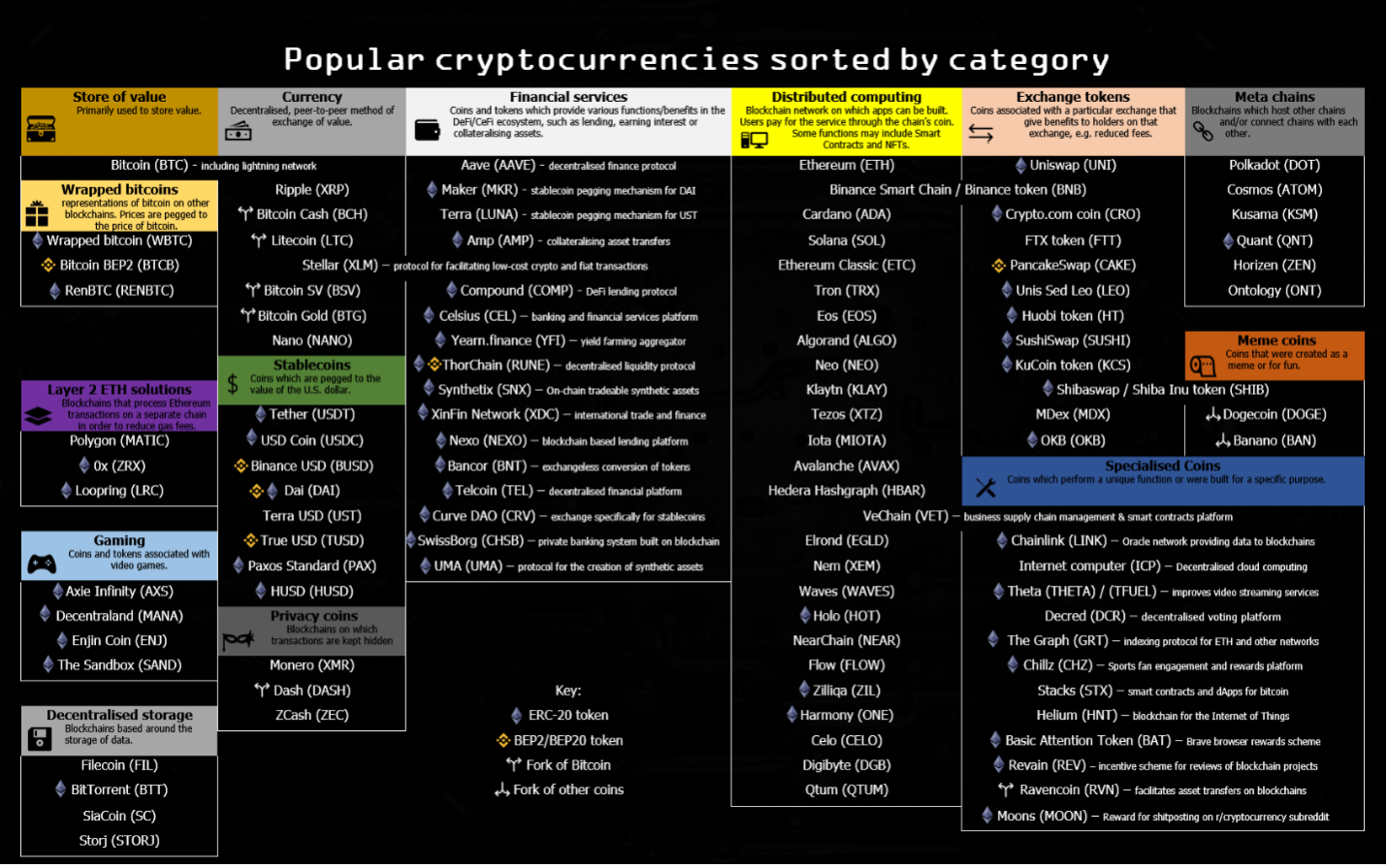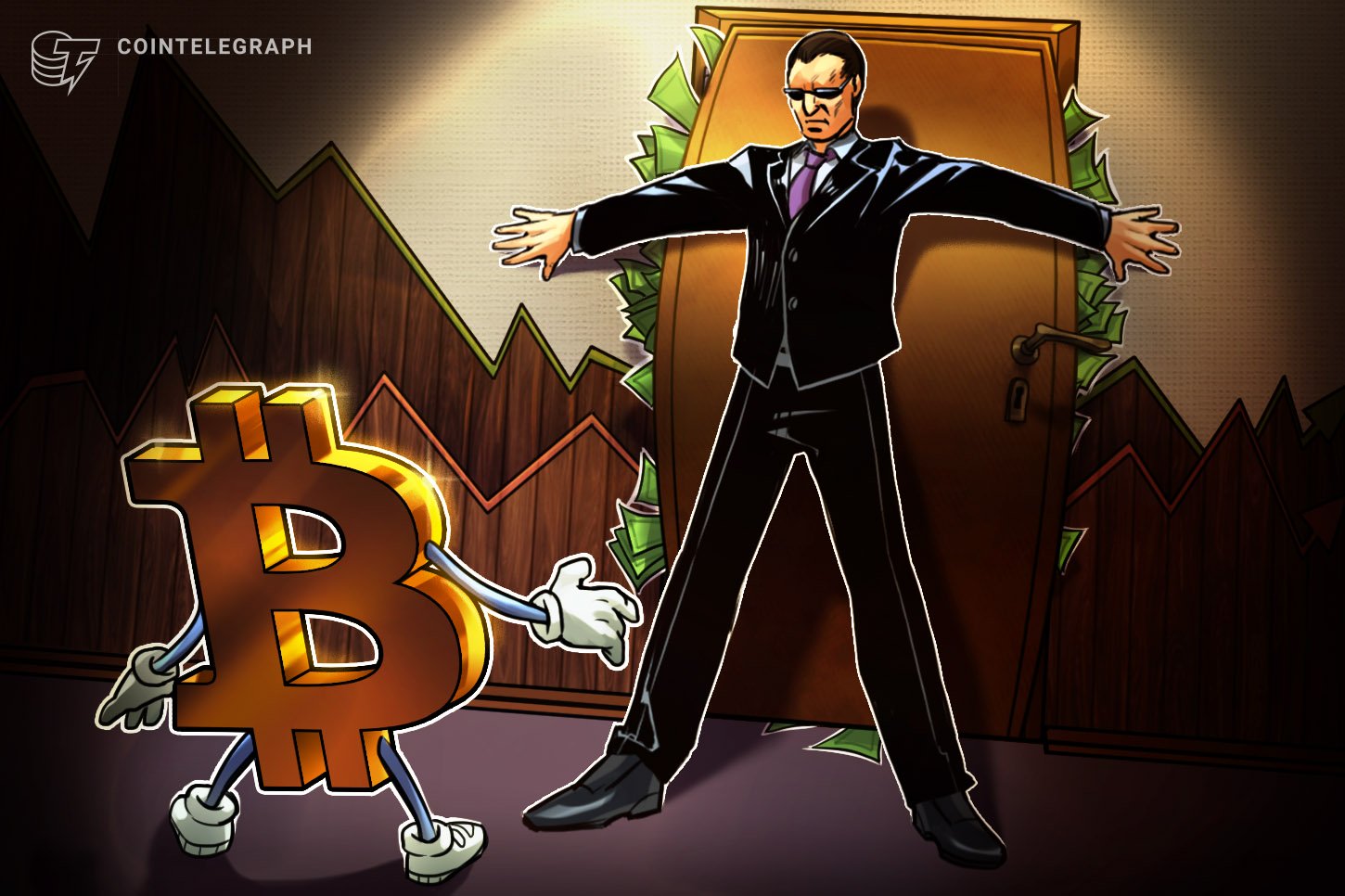
Huge thanks to Reddit user Wargizmo, who put together the chart above, one of the most helpful I’ve ever seen. (Full version here.)
I call this an investing superpower.
Many people buy crypto without knowing what their project actually does. This is like buying a stock because your salon stylist told you it was hot. Smart stock investors research the underlying company, and smart block investors do the same.
This chart is similar to the concept of “business sectors” in the traditional stock market. To learn to wield this superpower, let’s first explore the concept of sectors.

The Power of Sector Investing
Sectors let you group companies by industry. For example, a traditional stock investor might want to invest primarily in IT companies, and avoid real estate companies. Using sector investing (or sector-specific funds), they could focus their investments on those industries.
The commonly accepted sector categorization is called the Global Industry Classification Standard (GICS), with sectors like Energy, Materials, and Health Care. (The biggest problem with GICS is the name. “Superpower” is much better.)
If GICS lists the sectors of the stock market, the chart above lists the sectors of the block market. Here it is again, so you can let this sink in:

Sectors are like a superpower, because they let you clearly see categories within the blockchain industry – a kind of X-ray vision. This gives you insights into which “companies” are going to be the winners in each sector of blockchain.
Put another way, it lets you predict which tokens will dominate their respective categories.
Compare this with the usual view of blockchain — by market cap — and you can see this chart brings structure and order to the industry. It lets you pick a winner in the categories that matter.
As blockchain investors, we must know our sectors. (Which rhymes.) Let’s go through each of the sectors in this chart, in order of potential investment opportunity.
 Store of Value
Store of Value
(excellent potential)
There’s really only one player here: bitcoin (BTC). While bitcoin has not widely caught on as a currency, it has caught on as a store of value, like “digital gold.” This is why, for example, more companies are storing part of their cash reserves in bitcoin.
This store of value argument is why many investors believe, “If you’re going to only invest in one digital asset, let it be bitcoin.” They believe that despite short-term volatility, bitcoin is an excellent long-term store of value. (Bitcoin is the foundation of our Blockchain Believers Portfolio.)
 Distributed computing
Distributed computing
(excellent potential)
I would call this category “Blockchain platforms,” and it’s probably the easiest crypto investment decision, behind bitcoin. If you believe blockchain is here to stay, then people will need platforms to develop on it – in the same way they need Windows, Mac, or Android operating systems to develop apps.
The 800-pound gorilla in this category, of course, is Ethereum (ETH). In some ways, Ethereum seems like the most undervalued “company” in the world, with a global community of users, developers, and platforms being built on top of it at a furious pace. It can be seen as the infrastructure of the “Internet of Value.”
That said, Ethereum is not a lock: plenty of technology platforms rise to early dominance, only to lose their lead (Betamax, MySpace, IBM). Other worthy contenders include Binance Smart Chain (BNB), Cardano (ADA), Algorand (ALGO), and others.
We may end up with:
1) Ethereum as the clear leader, and a handful of smaller blockchains specializing in niche applications. (Think about a virtual monopoly, like Google vs. all the other search engines.)
2) Two big competing blockchains (an oligopoly, like Windows vs. Mac OS).
Right now, Scenario #1 seems more likely. If so, Ethereum investors are likely to be handsomely rewarded.
 Financial services
Financial services
(excellent potential)
There’s a lot of hype in the blockchain industry, but in the case of Decentralized Finance (DeFi), the hype is probably warranted. In our view, DeFi platforms are so important to the future of finance that we’ve written several guides on How to Invest in DeFi, How to Evaluate DeFi, and How to Find DeFi Unicorns.
Using DeFi products is still a bit technical and wonky, but once you learn how they work, they are so much better than traditional financial products — like online banking and online brokerages — that there’s really no comparison. It’s like upgrading from travel agents to Google Flights. And DeFi apps will get even better and easier to use.
DeFi investments are generally riskier than the rest of the block market: it’s the leading edge of the leading edge. But the potential returns are also much greater. If you want to invest in DeFi, consider the projects with the largest market cap: this generally means they have the most users, and are in a good position to become category leaders.
 Exchange tokens
Exchange tokens
(some potential)
Exchanges are a critical part of the blockchain ecosystem: it’s where you buy, sell, and trade one digital asset for another. Since this is the single largest use case for blockchain today (trading tokens), you’d think digital exchanges would be a perfect investment opportunity.
The challenge is that it’s really hard to run a traditional exchange, given the continual tangle of legal and regulatory challenges. Each country’s laws are constantly changing as they figure this stuff out, but meanwhile blockchain is a global, borderless system that’s happening 24 hours a day.
The history of blockchain is already littered with the bodies of exchanges that have come and gone. Who will be left standing in the end? As Yoda might have said, “Impossible to see the future is.”
 Stablecoins
Stablecoins
(some potential)
Stablecoins – or digital assets that hold their value, typically 1:1 with the U.S. dollar – are one of the fastest-growing sectors in blockchain. The two behemoths are Tether (USDT) and USD Coin (USDC), the latter issued by Circle, which will soon go live as a publicly-traded stock (see our guide on How to Invest in Circle).
The issue is that it’s hard to make money with stablecoins, since the price doesn’t move. You can, of course, earn “interest” on them (typically called “yield”) using new DeFi protocols (see our page of best DeFi interest rates). This can be a valuable part of an investing strategy, like storing part of your traditional money in a CD or money market fund.
Stablecoins are “safe,” but with low risk comes low reward. (And they’re not completely without risk — they could still be taxed out of existence by governments.) For bigger returns, look elsewhere.
 Decentralized storage
Decentralized storage
(some potential)
Let’s say you have a massive hard drive – a couple of spare petabytes – and you’re only using a fraction of that storage space. You can “lease” your unused storage for other people to use, then get paid in blockchain tokens. On the other side, users with massive files can “rent” the storage at a cheap rate.
This is the promise of decentralized storage, which is still in its early days, but interesting to watch. Filecoin is the leader, and probably the best investment opportunity (it’s hard to imagine BitTorrent gaining widespread usage, given its history as a piracy platform).
The key “tipping point” is if/when these decentralized storage systems begin to be widely adopted by companies and enterprises. Until then, most investors will probably “wait and watch.”
 Gaming
Gaming
(some potential)
Blockchain economies are similar to videogame economies: the kind where you buy real money to buy virtual goods, like custom skins and weapons. So there’s some overlap here, but certainly no category leader yet. It will be an interesting (and fun) space to watch.
One project to check out is Decentraland (MANA), which lets you use cryptocurrencies to buy virtual assets in this fully-immersive VR world. If you want to invest in real estate, but can’t afford “real” real estate, you can buy plots of land – virtual real estate – in Decentraland. No idea on whether Decentraland will be around in ten years, but virtual real estate is certainly a trend of the future.
 Meta Chains
Meta Chains
(some potential)
These are technologies that provide interoperability between blockchains – transferring data between Ethereum and Cardano, for example. As an example, imagine investing in a company that provided interoperability between Windows and Macs. Those companies do exist, but they’re usually a tiny fraction of the overall Windows/Mac market. Probably best for most casual investors to hold off.
 Currency
Currency
(limited potential)
The great irony is that “cryptocurrencies” aren’t really currencies. Of course, a few weird convenience stores accept Bitcoin, but you can’t really use crypto to buy things in the real world, like traditional money.
So the “Currency” investments on the chart above are probably not great long-term investments. Ripple (XRP) could be the exception, as it is designed for a specialized type of payment — international money transfers — but Ripple is currently the subject of an SEC investigation (see our article on SEC vs. XRP).
The bigger issue is that over 80 governments around the world are already working on their own Central Bank Digital Currency, which will offer the convenience of digital money, but backed by the government. Once CBDCs are rolled out at scale, why would people use any other digital currency?
 Privacy Coins
Privacy Coins
(limited potential)
One reason you might use another currency is if you want to stay completely anonymous. Bitcoin and other cryptocurrencies are only partially anonymous — you can still view the complete history of transactions on a blockchain — but privacy coins are a black box.
While privacy coins are used for legitimate reasons — to protect personal privacy, or to escape tyrannical governments — they’re also used for shady transactions, which makes them unlikely to ever achieve widespread usage. Plus, all the challenges listed in the “Currency” sector above still apply.
 Wrapped bitcoin
Wrapped bitcoin
(limited potential)
This is what is known as a derivative, or a digital asset built on top of another digital asset. The problem with derivatives is they get increasingly complicated and risky for most investors (I always link to the Selena Gomez scene from The Big Short).
Assets-built-on-assets leads to assets-built-on-assets-built-on-assets, and the whole Jenga Tower can quickly come crashing down (I always link to the Ryan Gosling/Steve Carrell scene from The Big Short).
 Layer 2 ETH solutions
Layer 2 ETH solutions
(limited potential)
This is new technology being built on top of Ethereum. For most investors, ask yourself the simple question: if you believe in Ethereum so much, why not just invest in Ethereum?
 Meme coins
Meme coins
(limited potential)
Feel free to invest in Dogecoin, just because it’s fun. Especially if you think it’s fun to lose all your money.
 Specialized coins
Specialized coins
(mixed bag)
Finally, there’s the “everything else” category: are all the wonderful and weird experiments being tried on blockchain. These are worth watching, to see which ones are getting traction and potentially seeding new sectors.
The Sector Superpower, Summarized
Investing in blockchain projects using a sector view is like having “laser eyes” in real life.
While everyone else is chasing “price trends,” or looking at “social media sentiment,” or any of the other hundred flavors of crypto craziness, you can cut through the chaos.
Sectors give you a calm, logical view of blockchain investment opportunities, by category. The process is:
- Understand each sector.
- Decide which sectors are going to be the most important, long-term.
- Then find the 1 or 2 leaders in each sector.
- Invest accordingly, following our Blockchain Believers Portfolio.
- Profit.
I am a highly experienced writer and editor in the cryptocurrency field. I have written for numerous publications, including CoinDesk and Bitcoin Magazine. I am also the author of two books on cryptocurrency investing. I am passionate about blockchain technology and its potential to change the world, and I firmly believe that cryptocurrencies are here to stay forever.




